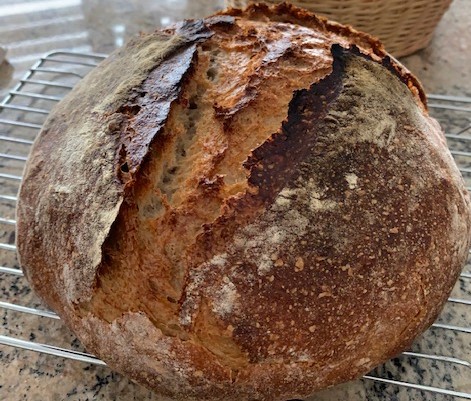Sharing the Sourdough Love

Back in January, pre-pandemic, my dear friend Fred Armstrong traveled across the Salish Sea to visit us for a weekend. Along with his sister Terry, and bountiful good humour, he brought me some sourdough starter. He knows I am a devoted cook, and the kitchen is my happy place. Learning to make my own bread has been a joy-- it has also been a comfort-- both nourishing to the body and soothing to the soul. Since then, I've experimented a lot, and continue to practice and play. I've begun splitting Fred's starter, first creating a batch of rye starter for a change in flavour and then splitting out batches of both white and rye starter to share with people, many of whom are finding it hard to find packaged yeasts in stores, or who are finding baking and cooking a good way to spend found time.
I love that the starter is spreading in the community-- a healthy kind of bacteria! As well, it warms my heart to think that as we self-isolate to keep each other safe, we are sharing a practice that is so sustaining.
I started with this very simple recipe from An Oregon Cottage. It is easier than many recipes and gives you a lovely same-day loaf - I do adapt this recipe as it sometimes doesn't suit my schedule or if I want a more fermented or more truly sour sourdough.
It's important to keep your starter healthy -- here is an excellent little video on feeding your starter from my dear friend Rebecca Coleman. She has a great food blog called Cooking By Laptop.
Here are my tips, using the Oregon Cottage recipe:
1. I use 2c all purpose white, and 1 c dark rye and so far that is my favourite combo, but you can play around as long as it is 3c total flour (works well with either white or rye starter, but rye starter gives a bit deeper flavour)
2. I do the first rise on top of the stove with just the hood light on overhead
3. I now set the oven to 500 and then lower it to 450 when I put the bread in for the covered part of the bake, and then leave at 450 for the remainder of the bake
4. Depending on the hydration, I bake it for 25 mins covered rather than 15 and the same for uncovered bake - sometimes even 25 - I just watch the colour - BUT your stove may vary, perhaps start at the recommended temp and then adapt
5. I find I get a better crust if I either 'oven cure' the bread (this doesn't always work....) or set my cooling rack up on something high (I use two tall metal thermos-go cups and set the rack on top) so the air can circulate while it cools.
6. If I need to retard the process because of my schedule, I will fridge proof the bread for the second rise, even overnight. this gives a more sour taste and a more truly sourdough texture as well. You can experiment with this...I also find increasing the hydration, even just a tablespoon or two or using amore runny starter produces a more traditional sourdough - a holier crumb and chewier crust
One note re: Dutch Oven - I use a Le Creuset with great success, but because of the high baking temp the pot gets grubby. I recommend using an old one.
There are lots of recipes and resources online. The recipe I've linked to above is very reliable and a good basic one to get started with and then experiment from there. It is also an excellent same-day loaf made from starter. This list of videos below came from my friend Fred, along with his commentary. He is a bread-making maestro.
Have fun! Be well.
Here’s the best videos on making various sourdough breads. These are YouTube links;
Great basic guide
Rye sourdough. Very yummy.
America’s Test Kitchen
This is a great overall primer on the bread.
A quick start method.
This is an amazing pro tip on bread making
PS - If you need anything, don't hesitate to reach out.
I love that the starter is spreading in the community-- a healthy kind of bacteria! As well, it warms my heart to think that as we self-isolate to keep each other safe, we are sharing a practice that is so sustaining.
I started with this very simple recipe from An Oregon Cottage. It is easier than many recipes and gives you a lovely same-day loaf - I do adapt this recipe as it sometimes doesn't suit my schedule or if I want a more fermented or more truly sour sourdough.
It's important to keep your starter healthy -- here is an excellent little video on feeding your starter from my dear friend Rebecca Coleman. She has a great food blog called Cooking By Laptop.
Here are my tips, using the Oregon Cottage recipe:
1. I use 2c all purpose white, and 1 c dark rye and so far that is my favourite combo, but you can play around as long as it is 3c total flour (works well with either white or rye starter, but rye starter gives a bit deeper flavour)
2. I do the first rise on top of the stove with just the hood light on overhead
3. I now set the oven to 500 and then lower it to 450 when I put the bread in for the covered part of the bake, and then leave at 450 for the remainder of the bake
4. Depending on the hydration, I bake it for 25 mins covered rather than 15 and the same for uncovered bake - sometimes even 25 - I just watch the colour - BUT your stove may vary, perhaps start at the recommended temp and then adapt
5. I find I get a better crust if I either 'oven cure' the bread (this doesn't always work....) or set my cooling rack up on something high (I use two tall metal thermos-go cups and set the rack on top) so the air can circulate while it cools.
6. If I need to retard the process because of my schedule, I will fridge proof the bread for the second rise, even overnight. this gives a more sour taste and a more truly sourdough texture as well. You can experiment with this...I also find increasing the hydration, even just a tablespoon or two or using amore runny starter produces a more traditional sourdough - a holier crumb and chewier crust
One note re: Dutch Oven - I use a Le Creuset with great success, but because of the high baking temp the pot gets grubby. I recommend using an old one.
There are lots of recipes and resources online. The recipe I've linked to above is very reliable and a good basic one to get started with and then experiment from there. It is also an excellent same-day loaf made from starter. This list of videos below came from my friend Fred, along with his commentary. He is a bread-making maestro.
Have fun! Be well.
Here’s the best videos on making various sourdough breads. These are YouTube links;
Great basic guide
Rye sourdough. Very yummy.
America’s Test Kitchen
This is a great overall primer on the bread.
A quick start method.
This is an amazing pro tip on bread making
PS - If you need anything, don't hesitate to reach out.



